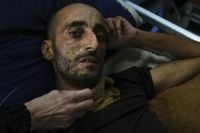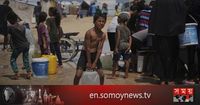As a punishing heatwave sweeps across the Gaza Strip, thousands of displaced Palestinians are grappling with an escalating humanitarian crisis, where the struggle for clean water is now compounded by soaring temperatures and relentless hardship. On August 14, 2025, the crisis reached a new peak as temperatures in central Gaza soared to 36°C (97°F), making daily survival a test of endurance and resourcefulness for families already battered by nearly two years of conflict.
According to the Associated Press, the heatwave has deepened the suffering of displaced people in Gaza, where shortages of food and water have become daily realities. In the city of Gaza, makeshift tent camps have sprung up amid the rubble of destroyed buildings, offering little protection from the sun. Here, families huddle in the scant shade, hoping for a reprieve that never seems to come.
Inside the yard of Shifa Hospital in Gaza City, a warehouse has been converted into a shelter for patients. But there is no air conditioning. On August 13, 2025, a Palestinian patient was seen sweating profusely, seeking relief by sitting near a fan—one of the few comforts available. The scene, captured by AP photographer Jehad Alshrafi, underscores the dire conditions faced by those with nowhere else to turn.
Children, too, are on the front lines of this crisis. On August 12, 2025, a young Palestinian boy was spotted carrying jerrycans after collecting water from a distribution point in Gaza City. For many, this daily ritual is a lifeline. In Deir al-Balah, central Gaza, a young girl ran to a water distribution point with an empty basin, determined to secure enough water for her family. The temperature that day reached a sweltering 36°C, yet the line for water showed no signs of thinning.
Water, in fact, runs through every part of Gaza’s humanitarian struggle. Displaced Palestinians gather at trucks delivering water in Khan Younis, desperate to fill buckets, basins, and anything else that might hold precious drops. According to AP reports, on August 13, 2025, Rana Odeh was seen carrying buckets full of water next to her makeshift shelter in Muwasi, Khan Younis. In the same area, a girl pushed a cart loaded with jerrycans, each one a small victory against dehydration and disease.
The daily hunt for water is not just exhausting—it’s expensive. In Gaza City, a man was seen selling plastic bags of water for one shekel each. On August 12, a child received water from such a bag, a transaction that has become all too common as infrastructure collapses and traditional sources of clean water dwindle.
At desalination plants in Deir al-Balah, crowds gather to collect drinking water. The process is slow and the supply limited, but for many, it’s the only option. Children buy bags of drinking water, clutching them tightly as they make their way back to tents and shelters. Every drop counts.
Families are forced to ration what little water they can find. Enaam Al Majdoub, for example, uses water collected from a distribution point to bathe her 3-year-old granddaughter, Jourieh, while her son Zaki uses some for cooking in their family tent. Their story, documented by AP, is echoed in countless households across Gaza, where daily routines have been upended by war and deprivation.
As the heat intensifies, so do the dangers. Without adequate water, the risk of dehydration and heat-related illnesses climbs sharply—especially for children, the elderly, and the sick. Patients at Shifa Hospital, already weakened by illness or injury, now face the added threat of heatstroke. Some seek relief by sitting near fans, but with no electricity for air conditioning, the respite is fleeting.
The humanitarian crisis in Gaza has been compounded by the Israeli government’s decision to intensify its 22-month war with Hamas. On August 14, 2025, Israeli forces took over Gaza City, a move that has stirred fresh fears for Palestinian civilians and Israeli hostages still held in Gaza. As reported by AP, this escalation has renewed international pressure for an end to the conflict, with global leaders calling for urgent action to address the suffering of civilians caught in the crossfire.
For many in Gaza, the war is an ever-present backdrop to their daily struggles. On August 12, 2025, a group of Palestinians sat in the shade of their tent amid the ruins of Gaza City, a stark reminder of the destruction that has upended their lives. The tents offer little protection from the heat, but with homes reduced to rubble, they are the only refuge left.
Children, who should be playing in the summer sun, instead carry jerrycans and buckets, their faces set with determination beyond their years. The search for water is relentless, and even small victories—like securing a bag of water or filling a jerrycan—are hard won.
International aid organizations have warned that the situation is unsustainable. Without immediate intervention, the combination of heat, displacement, and resource shortages could lead to a catastrophic public health crisis. Yet, as of August 14, 2025, relief efforts are hampered by ongoing hostilities and logistical challenges. Water trucks and distribution points are lifelines, but they cannot meet the overwhelming need.
The human stories behind the headlines are heartbreaking. Patients sweat in makeshift wards, children run for water under a blazing sun, and families ration every drop. The resilience of Gaza’s people is remarkable, but even the strongest spirits are tested by the relentless heat and scarcity.
As the world watches, the question remains: how much longer can Gaza’s civilians endure? The heatwave may eventually break, but the deeper crisis—of war, displacement, and deprivation—shows no sign of ending. For now, the people of Gaza continue to persevere, drawing strength from each other and from the hope that relief, somehow, will come.


